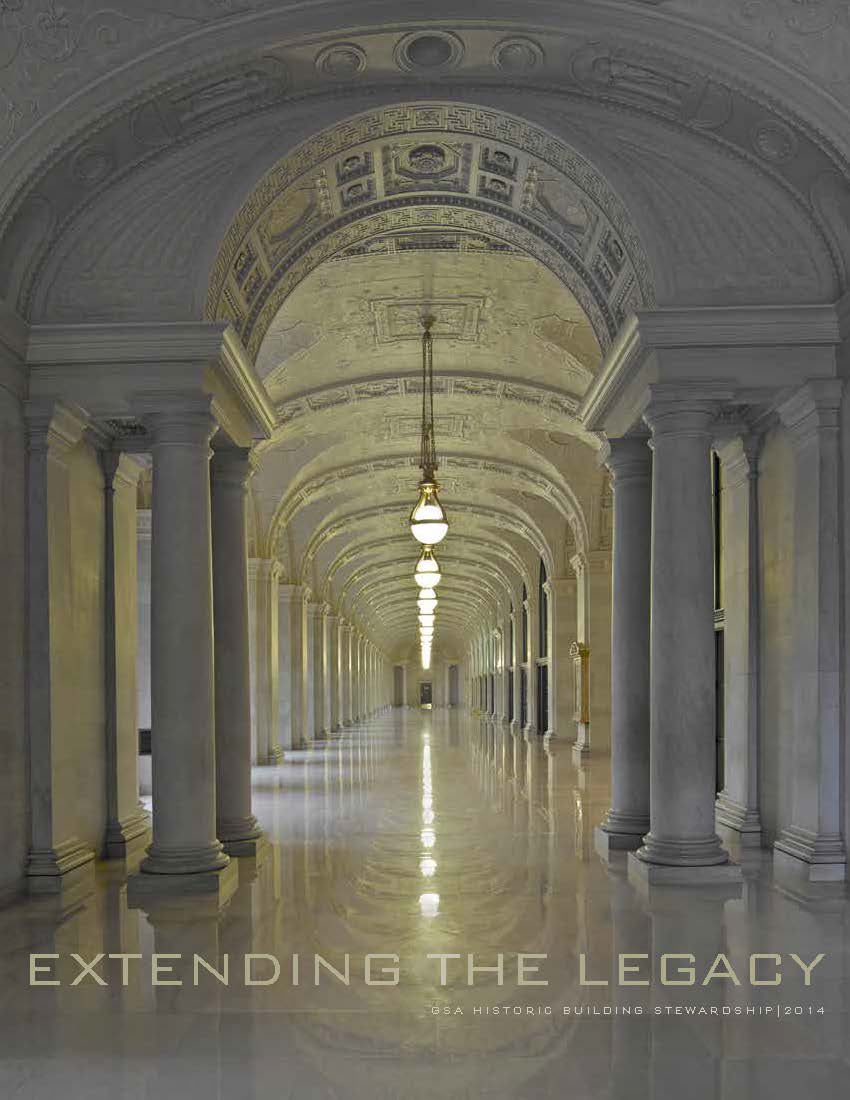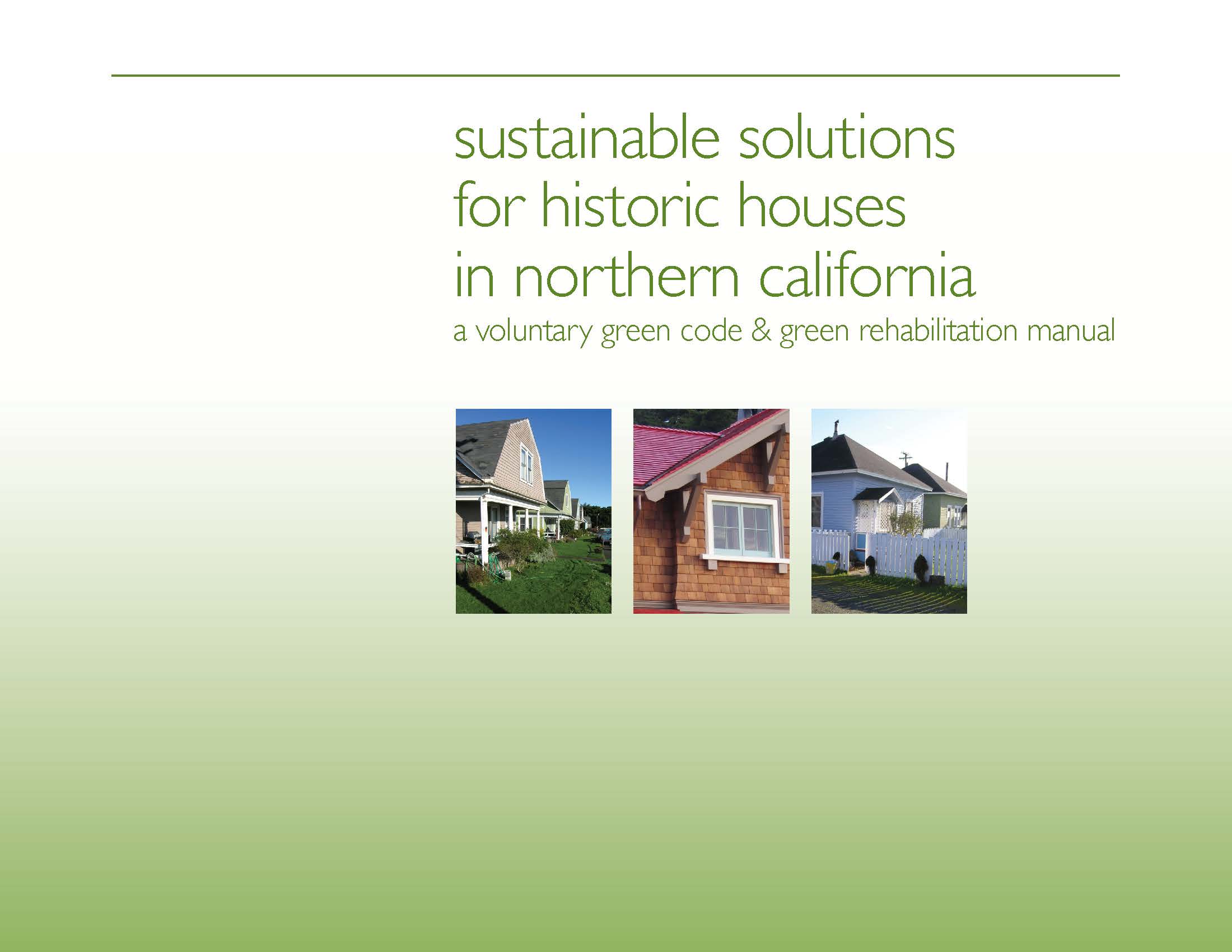Sustainable Guidelines and Publications
NPS Publications
Technical Preservation Services of the NPS has published several guidelines for appropriate incorporation of sustainable feastures and conservation of existing features. Click on the currently available publications.
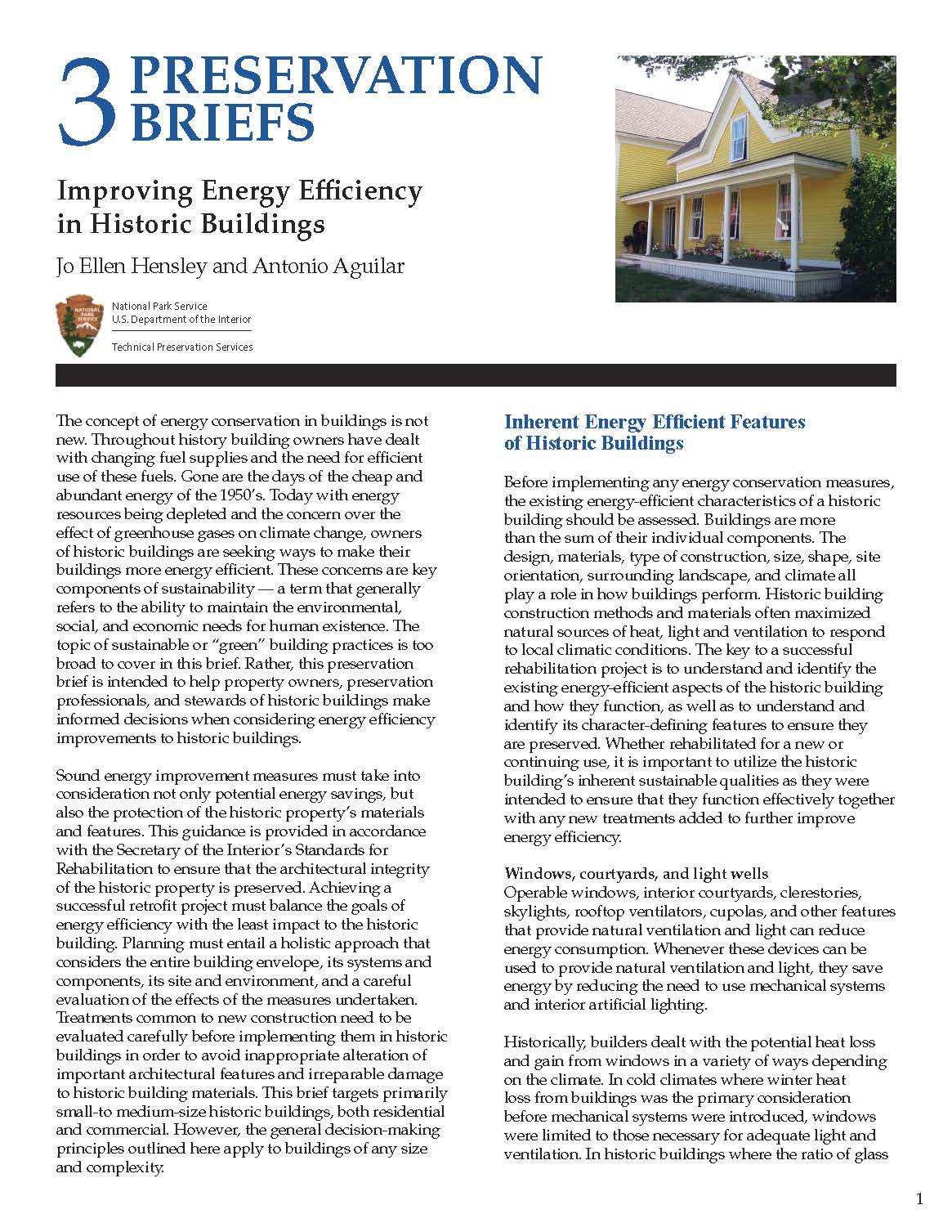
Achieving a successful retrofit project must balance the goals of energy efficiency with the least impact to the historic building. This revised and updated Preservation Brief considers sound energy improvement measures, potential energy savings, and also the protection of the historic property’s materials and features. The guidance provided is in accordance with the Secretary of the Interior’s Standards for Rehabilitation to ensure that the architectural integrity of the historic property is preserved.
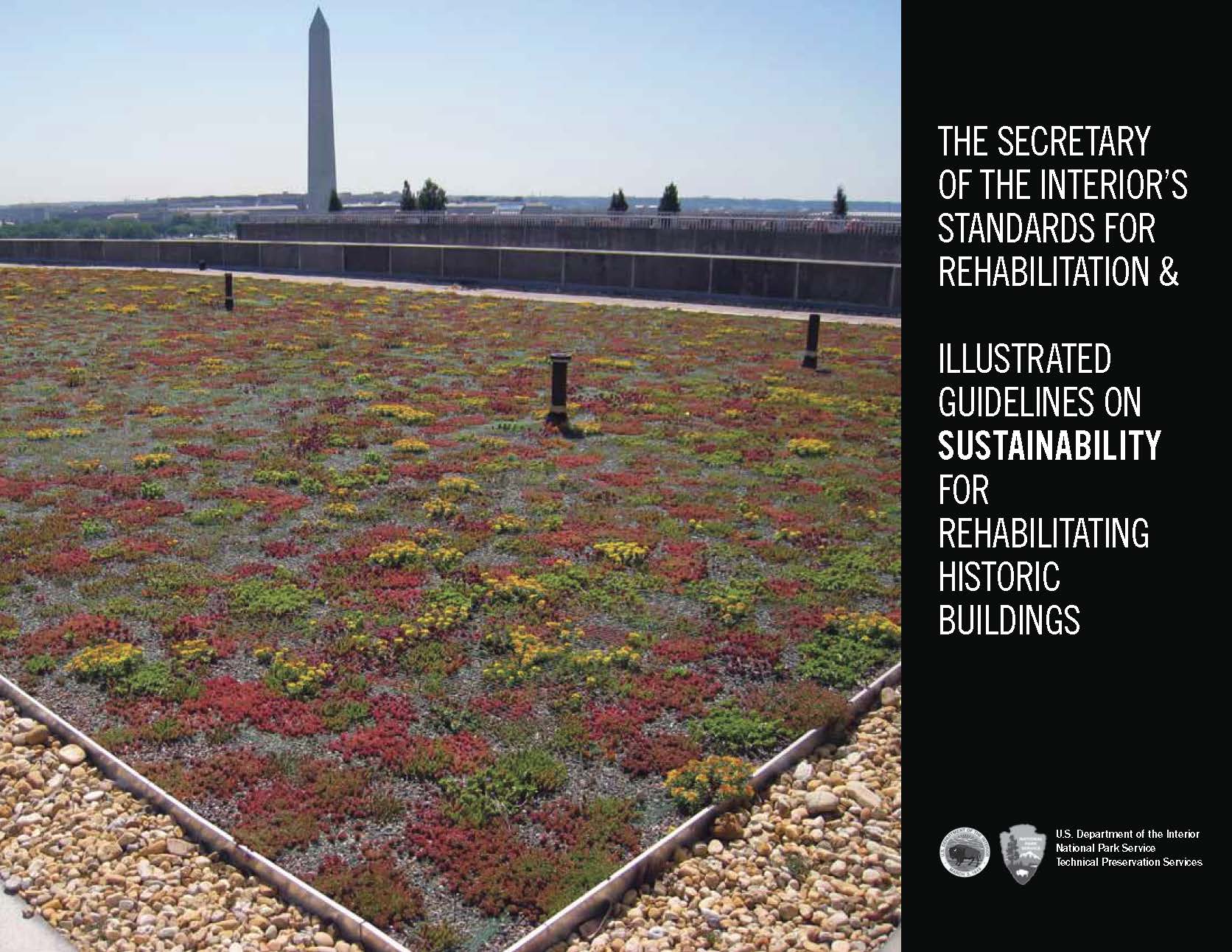
ILLUSTRATED GUIDELINES ON SUSTAINABILITY
The Illustrated Guidelines on Sustainability for Rehabilitating Historic Buildings replaces the chapter on “Energy Conservation” in the Illustrated Guidelines for Rehabilitating Historic Buildings published in 1992. The Illustrated Guidelines on Sustainability begin with an overview focusing on the fact that historic buildings are themselves often inherently sustainable and that this should be used to advantage in any proposal to upgrade them. These guidelines offer specific guidance on how to make historic buildings more sustainable in a manner that will preserve their historic character and that will meet The Secretary of the Interior’s Standards for Rehabilitation.
More sustainable preservation technical information is available on the NPS Sustainability web site.
National Trust for Historic Preservation Publications
OLDER SMALLER BETTER
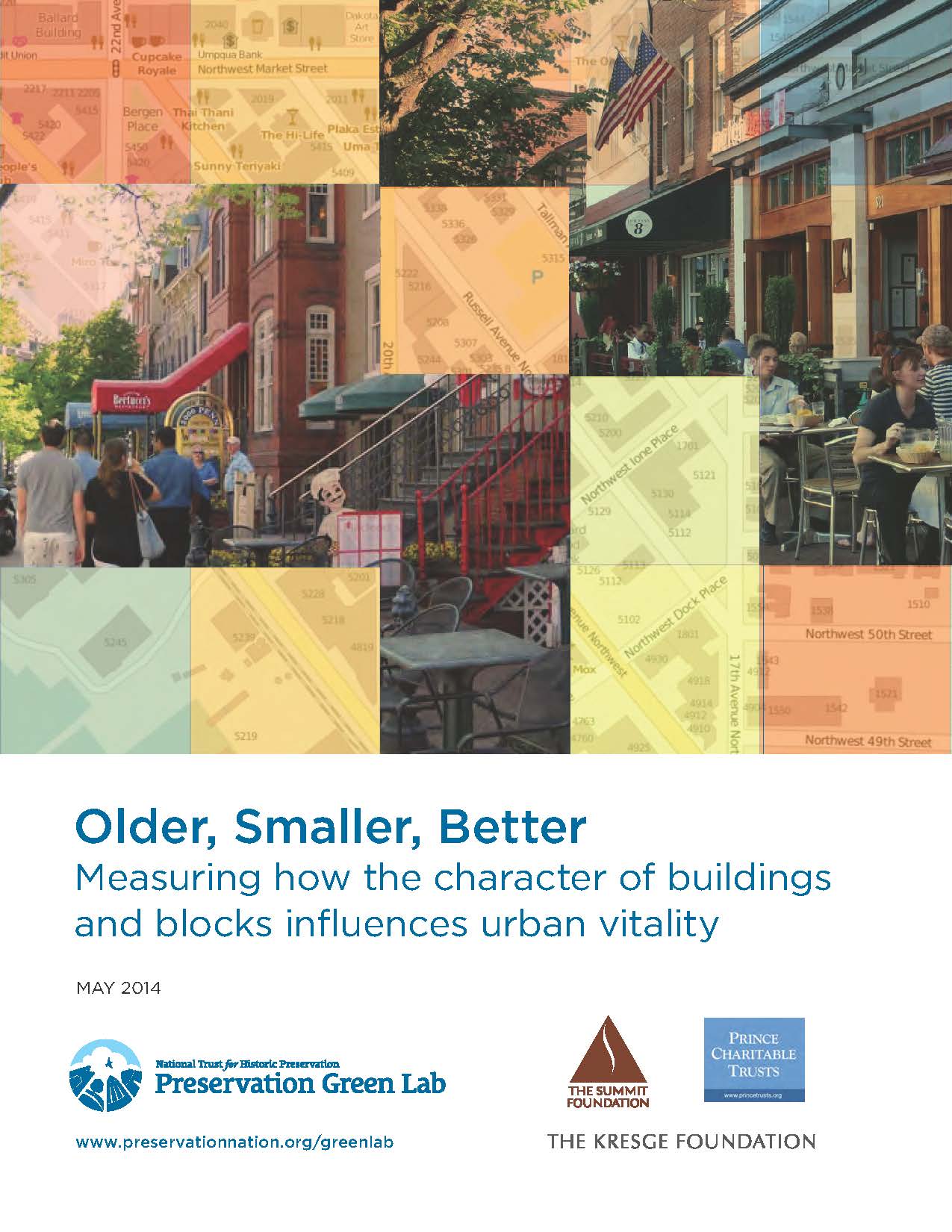
This groundbreaking study demonstrates the unique and valuable role that older, smaller buildings play in the development of sustainable cities. Building on statistical analysis of the built fabric of three major American cities, the research demonstrates that established neighborhoods with a mix of older, smaller buildings perform better than districts with larger, newer structures when tested against a range of economic, social, and environmental outcome measures. The report is just part of the research conducted by the NTHP - their older-smaller-better webpage expands the discussion.
REALIZING THE ENERGY EFFICIENCY POTENTIAL OF SMALL BUILDINGS
The Small Buildings and Small Portfolios (SBSP) sector represents 4.4 million small buildings, with an average size of approximately 8,000 square feet. These buildings contain 7.0 million business establishments, 84 percent (5.9 million buildings) of which are owned by small businesses, or firms with fewer than 500 employees. Conversely, approximately 16,000 larger firms hold portfolios totaling 700,000 buildings – an average of 46 buildings per firm. Compiling research conducted by the National Renewable Energy Laboratory, the Pacific Northwest National Laboratory, the Energy Star program, and the American Society of Heating, Refrigeration, and Air Conditioning Engineers, this compelling study demonstrates that cost effective energy savings of more than 45% are possible in small commercial buildings.
UNTAPPED POTENTIAL: STRATEGIES FOR REVITALIZATION FOR REUSE

Lessons learned are reflected from this multiyear partnership studying reuse in Baltimore, Chicago, Detroit, Los Angeles, and Philadelphia. This report summarizes the technical, market, financial, and regulatory barriers to building reuse, and offers best practices for policymakers, developers, and community advocates interested in building reuse as a tool to create sustainable, healthy, equitable, and resilient communities.
THE ROLE OF DISTRICT ENERGY IN GREENING EXISTING NEIGHBORHOODS

As cities look for innovative means of reducing carbon emissions, it becomes apparent that one effective way to achieve high levels of energy performance rests with district-level approaches to the built environment. This paper explores the vital role that low-carbon district energy systems (i.e., neighborhood-scale utilities that deliver thermal energy for heating, cooling, and hot water) can play in enabling existing buildings and established urban neighborhoods to meet aggressive emission reduction targets in a cost-effective way. It also highlights the essential role local governments must play in supporting the development of district energy systems, and is intended as a primer for communities that are beginning to look at district energy as a possible strategy for reducing their emissions and dependence on non-renewable energy sources.
Explore more current studies and reaearch at the National Trust for Historic Preservation website and the Preservation Green Lab.
Saving Windows, Saving Money: Evaluating the Energy Performance of Window Retrofit and Replacement
A report just produced by the National Trust for Historic Preservation Green Lab provides cost guidance for homeowners weighing the financial and energy tradeoffs between replacing or repairing older, less efficient windows. This report builds on previous research by examining multiple window improvement options, comparing them to replacement windows across multiple climate regions.

Key findings offer homeowners, contractors, architects and others with compelling evidence of the merits of retrofitting windows as opposed to outright replacement:
- Retrofit measures can achieve performance results comparable to new replacement windows. This study shows that there are readily available retrofit measures that can achieve energy savings close to new, high performance replacement windows when the performance for each upgrade option is taken into account.
- Almost every retrofit option Offers a better Return on Investment (ROI) than replacement windows. Findings from the cost analysis showed that new, high performance windows are by far the most expensive measure, costing at least double that of common retrofit options when considering materials, installation and general construction commonly required for an existing home. In all climate zones analyzed, cellular shades, interior storm panels and various exterior storm window configurations offer a higher average return on investment compared to new, efficient replacement windows.
- The Bottom Line. Retrofitting windows with high performance enhancements can result in substantial energy savings across a variety of climate zones. Selecting options that retain and retrofit existing windows are the most cost effective way to achieve these energy savings and to lower a home’s carbon footprint. Retrofits extend the life of existing windows, avoid production of new materials, reduce waste and preserve a home’s character.
The Greenest Building: Quantifying the Environmental Value of Building Reuse

"The Greenest Building: Quantifying the Environmental Value of Building Reuse" the eagerly anticipated report from the Preservation Green Lab of the National Trust for Historic Preservation is now available. This report which provides the most comprehensive analysis to date of the potential environmental benefit of building reuse, concludes that, when comparing buildings of equivalent size and function, building reuse almost always offers environmental savings over demolition and new construction.
The report’s key findings offer policy-makers, building owners, developers, architects and engineers compelling evidence of the merits of reusing existing buildings as opposed to tearing them down and building new.
- Reuse Matters: Building reuse typically offers greater environmental savings than demolition and new construction. It can take between 10 to 80 years for a new energy efficient building to overcome, through efficient operations, the climate change impacts created by its construction. The study finds that the majority of building types in different climates will take between 20-30 years to compensate for the initial carbon impacts from construction.
- Scale Matters: Collectively, building reuse and retrofits substantially reduce climate change impacts. Retrofitting, rather than demolishing and replacing, just 1% of the city of Portland’s office buildings and single family homes over the next ten years would help to meet 15% of their county’s total CO2 reduction targets over the next decade.
- Design Matters: The environmental benefits of reuse are maximized by minimizing the input of new construction materials. Renovation projects that require many new materials can reduce or even negate the benefits of reuse.
General Services Administration Guidelines and Studies
As the federal steward of most of the federal buildings in the nation, GSA has excelled in building acquisitions and maintenance. This is true of both energy efficiency, historic preservation, and their intersection. The GSA Resources web page has a wealth of information on technical competency documents, technical guidelines and technical references and specifications. Below are reports and guidelines that support both goals.
ASPINALL COURTHOUSE CASE STUDY
 This document was prepared by the U.S. Department of Energy’s National Renewable Energy Laboratory (NREL) in partnership with the General Services Administration (GSA) on behalf of the Department of Energy’s Federal Energy Management Program (FEMP).
This document was prepared by the U.S. Department of Energy’s National Renewable Energy Laboratory (NREL) in partnership with the General Services Administration (GSA) on behalf of the Department of Energy’s Federal Energy Management Program (FEMP).
As the largest owner of Federal buildings, the General Services Administration (GSA) is charged with managing and preserving buildings—more than one-quarter of which are listed or eligible for historic designation—in an efficient and sustainable manner. This challenge led GSA to consider aligning historic preservation renovations with net-zero energy goals.
The agency chose the Wayne N. Aspinall Federal Building and U.S. Courthouse, to prove that net-zero energy goals can be achieved not only in an older building, but one that has a bevy of preservation requirements from being listed on the National Register of Historic Places.
The Wayne Aspinall Federal Building is a three-story building with nearly 42,000 square feet of office space located in Grand Junction, Colorado. The building was constructed in 1918 and originally functioned as a post office and courthouse. The building was listed on the National Register of Historic Places in 1980 and currently houses nine Federal agencies. Heavily in need of extensive repairs, the building was nearly slated for disposal; however, funding from the American Recovery and Reinvestment Act of 2009 (ARRA) paved the way for a major renovation project, focusing on historic preservation and energy efficiency upgrades. GSA aligned its sustainability and environmental goals with historic preservation requirements, necessitated by the Aspinall Courthouse’s designation on the National Register of Historic Places. GSA leadership is aggressively pursuing avenues to eliminate—not just limit—the Federal government’s impacts on the natural environment.
Through a design-build contract, the renovation project successfully met historic preservation requirements, the Guiding Principles for High Performance and Sustainable Buildings, and achieved goals towards reaching net-zero energy.
GSA STEWARDSHIP REPORT 2014
Highlights of GSA accomplishments for the 2012–2014 reporting period includes sustainability Firsts: proof that historic buildings are the ultimate green investment came in noteworthy firsts: GSA’s first Leadership in Energy and Environmental Design (LEED) Platinum project at the Hipolito F. Garcia Federal Building and U.S. Courthouse in San Antonio, and GSA’s first target site net zero energy project at the Wayne N. Aspinall Federal Building and U.S. Courthouse in Grand Junction, Colorado.
GSA’s American Recovery and Reinvestment Act (ARRA) funded modernization of the Federal Building at 50 United Nations Plaza in San Francisco, now housing GSA’s Pacific Rim regional headquarters, was noteworthy for what it did not include—air conditioning. Taking advantage of the building’s natural ventilation, added daylight management, and temperate climate will save taxpayers thousands of dollars in energy costs each year. Click on the image or title to directly download a copy of the report.
TECHNICAL GUIDELINES, REFERENCES AND SPECIFICATIONS
Just two of the many technical guidelines, references, and specifications available on the GSA Resources web page.
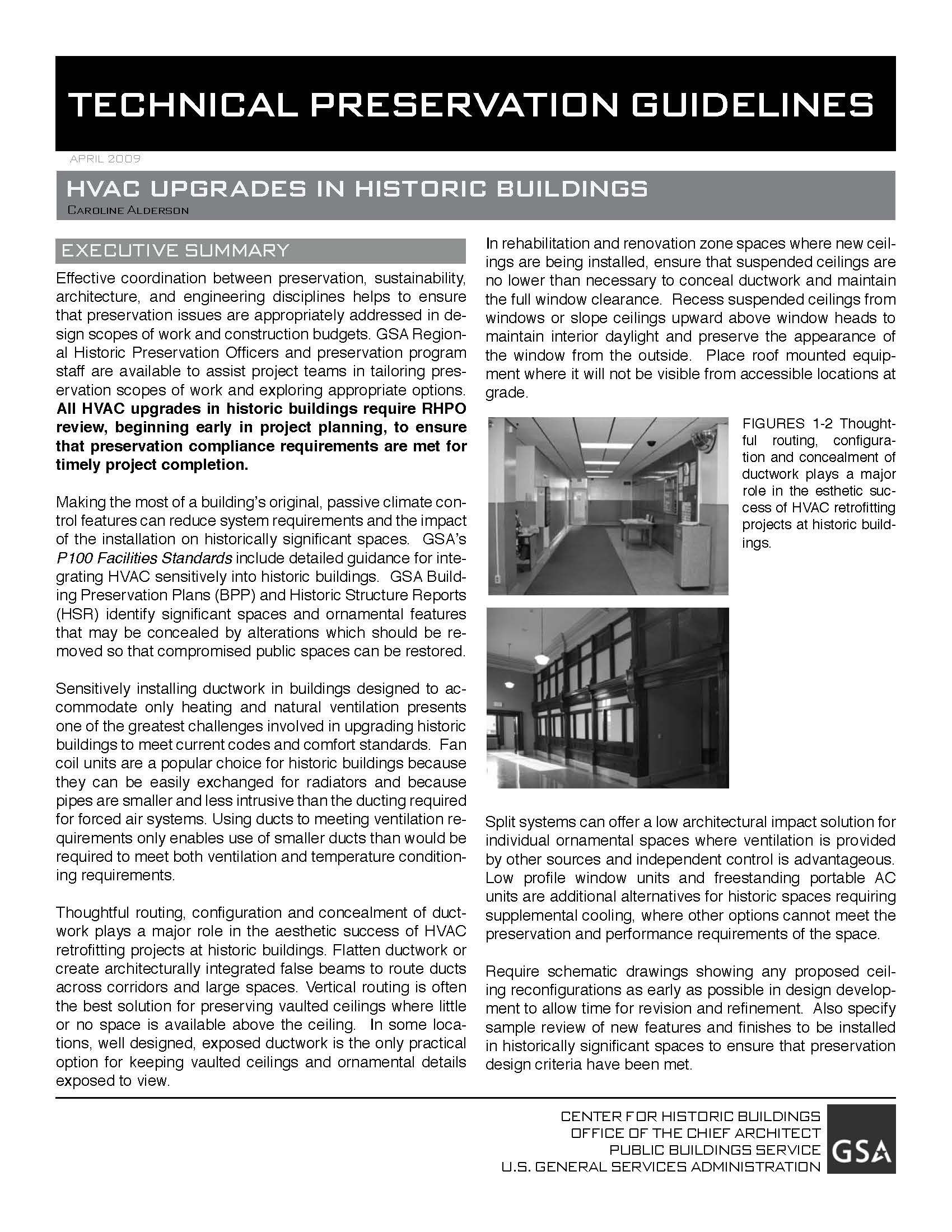
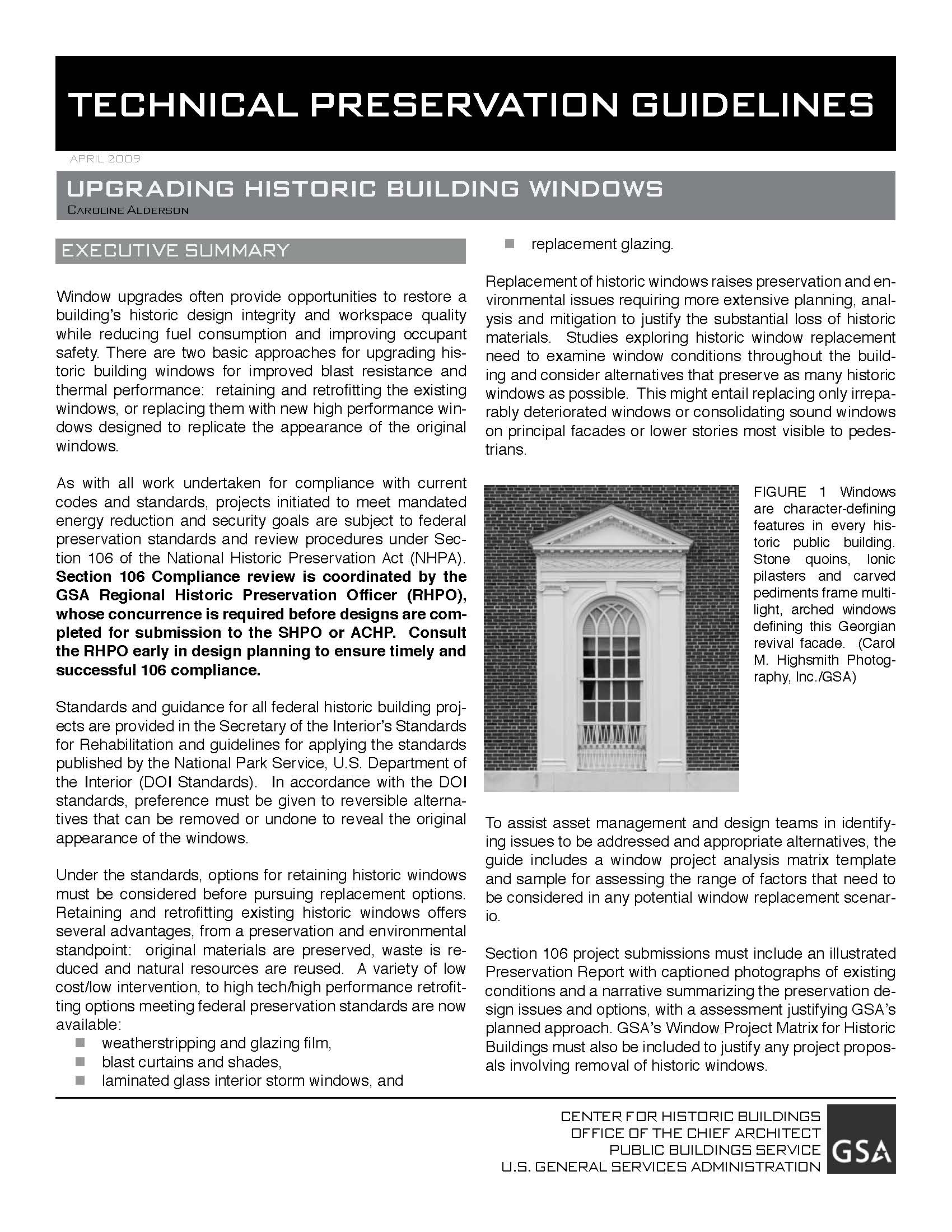
Additional Publications
EPA
SUSTAINABLE SOLUTIONS FOR HISTORIC HOUSES IN NORTHERN CALIFORNIA: a voluntary green code & green rehabilitation manual
This manual was created to help homeowners choose sustainable strategies for restoring and rehabilitating many of the smaller,Victorian-style, wood-framed houses built in Northern California during the late 1800s and early 1900s. Research for the Voluntary Green Code and Green Remodeling Manual included a site visit to Humboldt County, CA and assistance from local contacts and green building experts.The Samoa area has received EPA Brownfields support, including assistance with environmental site assessments.
Much of the research done for this manual focuses on Samoa, CA, a “company town” of historic, Victorian-style houses built during the redwood lumber boom in the early 1900s.The information also applies to many wood-framed houses built throughout the region around the same time period.
AMERICAN COUNCIL ON HISTORIC PRESERVATION
ASSESSING THE ENERGY CONSERVATION BENEFITS OF HISTORIC PRESERVATION: METHODS AND EXAMPLES (1979)
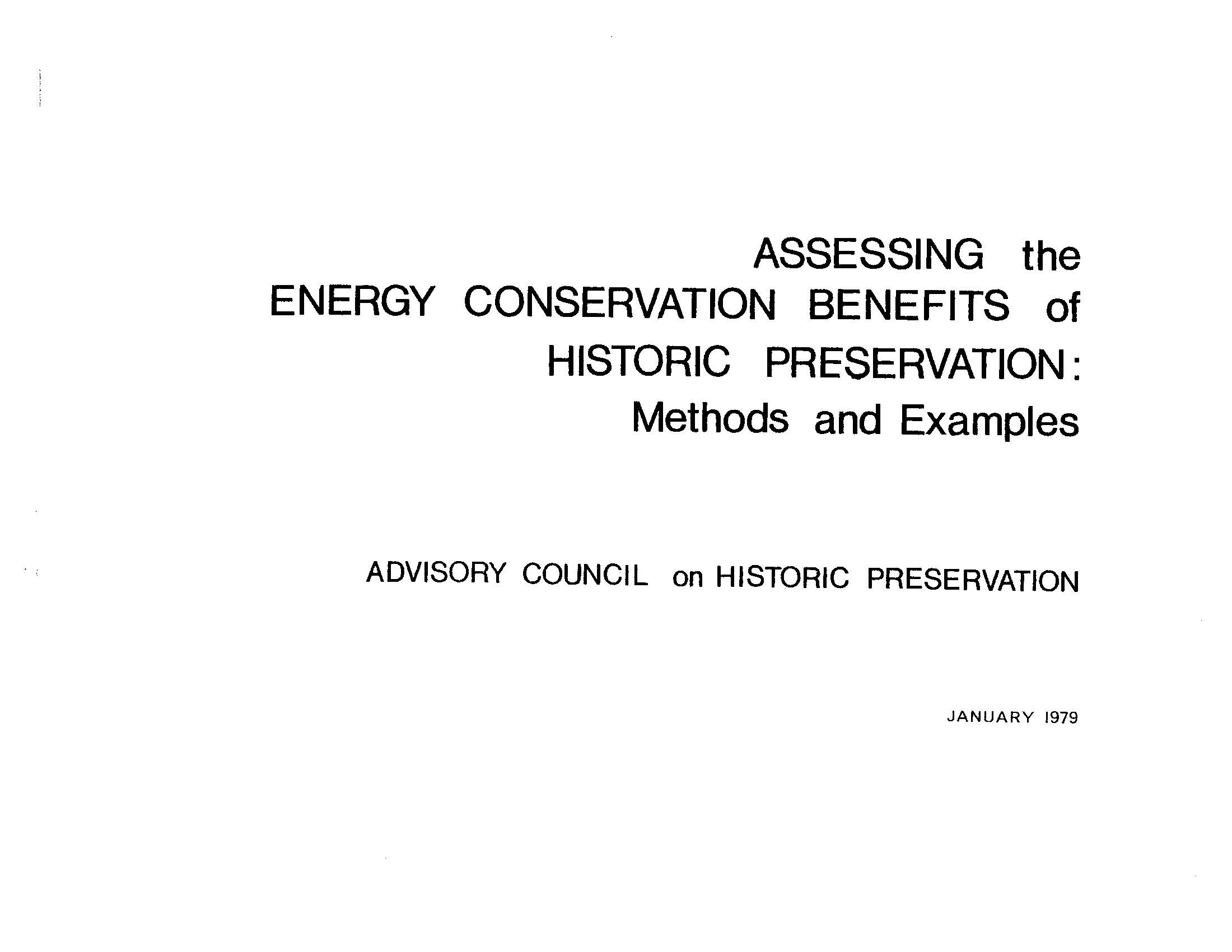 This study contains formulas to measure the energy needed to restore and rehabilitate existing buildings and compares that with the energy needed to demolish and replace them with comparable new construction. In this sense, it is similar to the study performed by the Preservation Green Lab and their report "The Greenest Building".
This study contains formulas to measure the energy needed to restore and rehabilitate existing buildings and compares that with the energy needed to demolish and replace them with comparable new construction. In this sense, it is similar to the study performed by the Preservation Green Lab and their report "The Greenest Building".
The Advisory Council on Historic Preservation developed these formulas to assist it in discharging its responsibilities under Section 106 of the National Historic Preservation Act, which requires Federal agencies to seek the comments of the Council when their undertakings affect properties listed or eligible for inclusion in the National Register of Historic Places, and Title I of the Public Buildings Cooperative Use Act, which requires the Council to advise the General Services Administration on the suitability of historic buildings in a given geographical area for needed Federal office space or other mixed uses. This study provided the Council with another tool for determining the total worth of historic structures, and, in specific cases, whether the retention and continued use of threatened properties are in the public interest.
In addition, formulas were used to compute the amounts of energy needed to rehabilitate and replace three NationalRegisterproperties: Lockefield Garden Apartments, an early Federal housing project in Indianapolis, Indiana, the Grand Central Arcade, a pivotal commercial complex in Pioneer Square Historic District, Seattle, Washington; and the Austin House, a three-unit apartment building converted from a carriage house in theCapitol Hill Historic District ofWashington,D.C. In each instance, analysis shows that renovation, instead of comparable new construction, results in impressive energy savings.
COUNCIL ON ENVIRONMENTAL QUALITY
OPPORTUNITIES TO ENHANCE THE NATION'S RESISTANCE TO CLIMATE CHANGE
The Resilience Council has worked with state, local, and tribal leaders, community organizations, academic institutions, philanthropic organizations, and the private sector to advance climate science and support on-the-ground decisions. To build upon and sustain this work, the Resilience Council identified a set of key opportunities using the following principles:
- Climate resilience should incorporate meaningful community engagement, fair and equitable outcomes, and targeted investments for communities that are often overlooked.
- Climate resilience should be coordinated among multiple stakeholders—including all levels of government, academic institutions, companies, and nonprofits—through partnerships, shared knowledge and resources, and coordinated strategies.
- Climate resilience should be mainstreamed into everyday decision making.
- Climate resilience should be a factor in fiscally responsible investments.
Opportunities are grouped into three themes. They are complementary to one another and, collectively, will help build climate resilience throughout the Nation:
- Theme 1: Advancing and applying science-based information, technology, and tools to address climate risk.
- Theme 2: Integrating climate resilience into Federal agency missions, operations, and culture
- Theme 3: Supporting community efforts to enhance climate resilience.
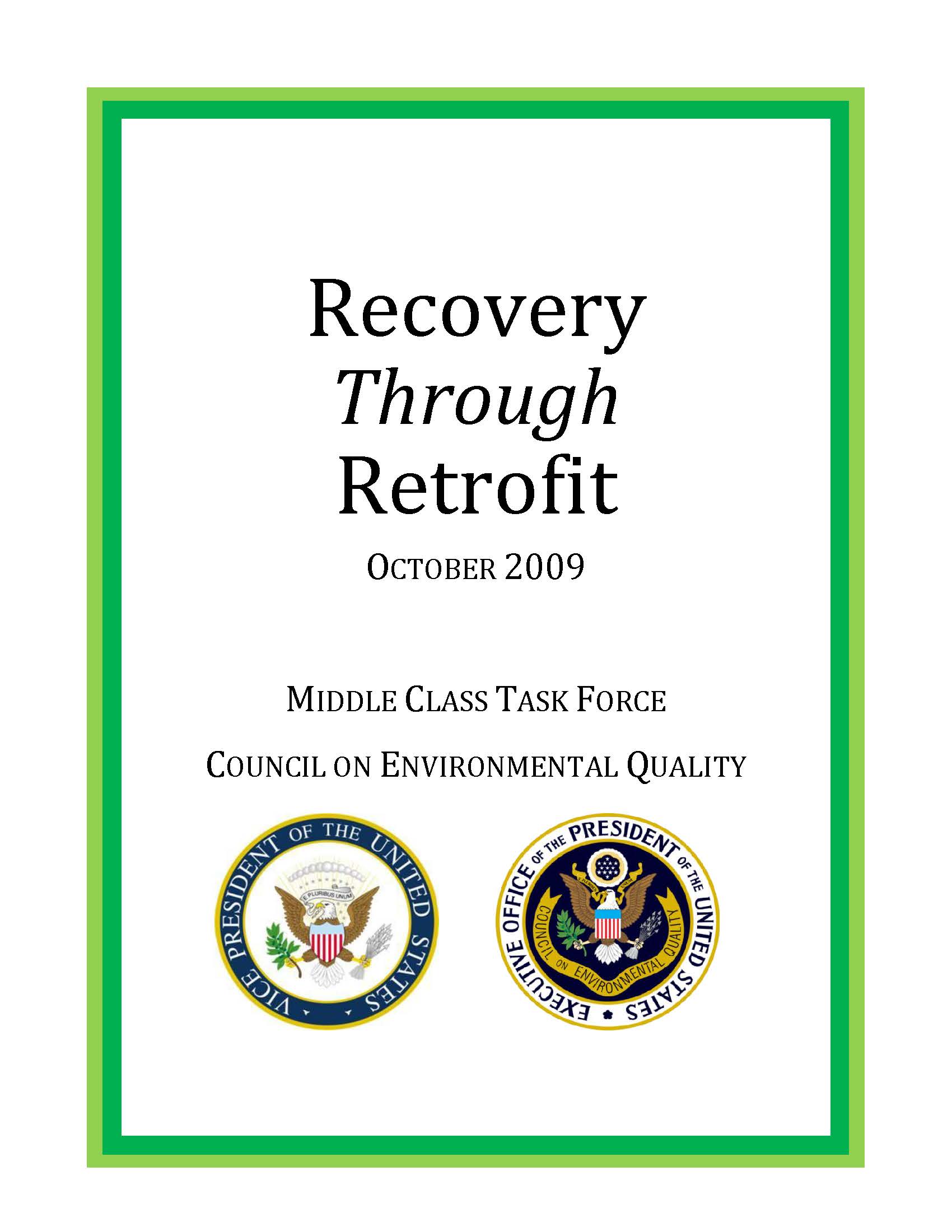
RECOVERY THROUGH RETROFIT (2009)
Making American homes and buildings more energy efficient presents an unprecedented opportunity for communities throughout the country. The Recovery Through Retrofit Report builds on investments made in the American Recovery and Reinvestment Act of 2009 (Recovery Act) to expand the home energy efficiency and retrofit market. Home retrofits can potentially help people earn money, as home retrofit workers, while also helping them save money, by lowering their utility bills. By encouraging nationwide weatherization of homes, workers of all skill levels will be trained, engaged, and will participate in ramping up a national home retrofit market.
The Recovery Act provides a unique opportunity to address access to reliable information, financing and workers skilled in home energy retrofits. Under the Recovery Act, state and local governments have an unprecedented opportunity to expand investments in energy retrofits and develop community-based programs on a large scale. These investments will put our country on a path to real reductions in greenhouse gases, and contribute to the economic recovery our country needs. The recommendations and actions in this Report have been carefully designed by eleven Departments and Agencies and six White House Offices to ensure that the energy efficiency market will thrive long after the Recovery Act money is fully spent.
By coordinating Recovery Act funds, Federal Departments and Agencies and resources; through building strong partnerships with states and local communities; and by targeting government policy changes, a foundation for self-sustaining energy efficiency retrofit market will be built. Through implementation of the Recovery Through Retrofit recommendations, the Federal Government will leverage private capital, streamline the retrofitting process, and reduce energy costs for homeowners.


